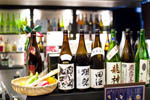Food Chisels

While you can use a number of everyday utensils to accomplish many of the same tasks, having a set of food chisels in the kitchen will serve you well. Once you familiarize yourself with them, you are bound to find new and inventive ways to incorporate them into your repertoire of techniques.
There are two types, curved and V-shaped. The curved edge is used for cutting holes or punching out half-moons, the V-shaped for more detailed work and a pointed cut. As the edges are extremely sharp, use them with care. Place a thick kitchen towel over your cutting board to protect it and the chisel edge.
Various Tools
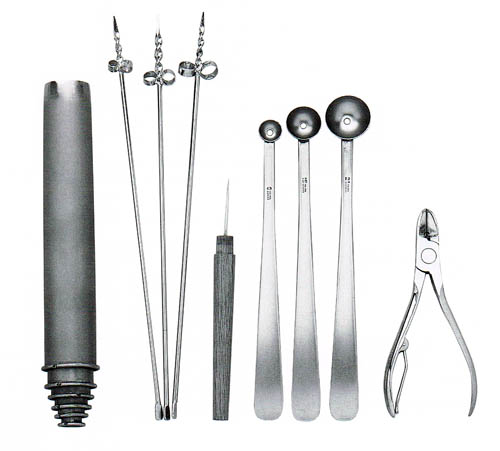
For miscellaneous work, I have a number of tools on hand. I include them here for your reference. Melon-ball scoops can be found in most kitchens, and most of you probably stock apple corers and some kind of pick. As for the rest of the tools, their functions can be covered by one or more everyday utensils.
A roll-call of the items from left to right reads as follows: corers/punches, corkscrew punches (handle not shown), needle pick, melon-ball scoops, and pincers.
Knives

Maintain a razor-sharp edge on your kitchen knives and keep a sharpening stone nearby. A fine edge will facilitate clean, accurate cuts.
While any good knife will work, in my professional capacity I use a one-sided blade because I believe it yields cleaner cuts and produces a nicer looking garnish. Since Japanese knives are gaining popularity, I thought I'd introduce some of them here.
The first two work especially well for carving garnishes, the next two for katsura-muki daikon sheets, and the last for sashimi. Listed by name from left to right, they are kurimuki-bocho ("chestnut-peeling" knife), usuba-bocho (thin-blade knife), mukimono-bocho (garnish knife, small and large), and yanagiba-bocho ("willow-leaf-shaped" knife).
Scalpels
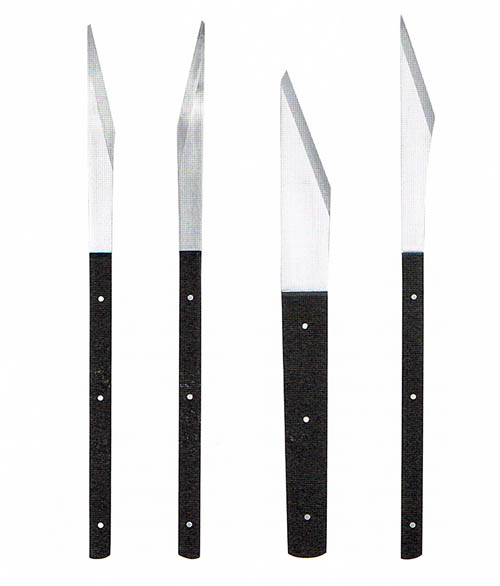
For detail work, it helps to have several smaller knives on hand. A thin-edged steak knife, finely sharpened, will serve the purpose in many instances.
Pictured here are professional Japanese scalpel-like cutting tools known as kiridashi.
Peelers
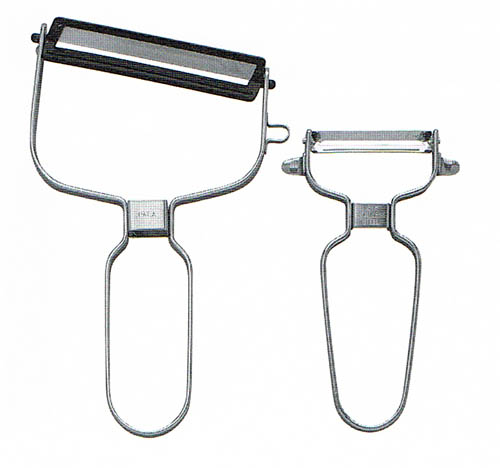
Peelers can be used for some of the garnishes in this book. Choose a sturdy one with a finely honed cutting edge.
To make a clean, even cut, employ it slowly and steadily.
Corers
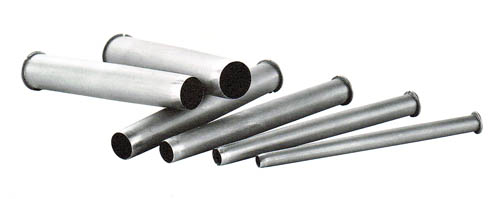
The circular corers have drawn some attention, so they are worth noting separately. These are sturdy, tubular tools with fine edges. When pressed against a food surface and rotated, they easily bore through the food.
As with food chisels, before using them protect the cutting surface and the tools edge by laying out a kitchen towel.
Source Notes
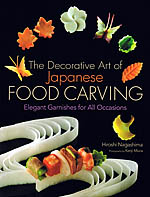
Reprinted with permission from the book:
The Decorative Art of Japanese Food Carving: Elegant Garnishes for All Occasions
Kodansha International
Japanese cuisine is renowned for the beauty of its presentation. Among the key elements in this presentation style are mukimono -- the decorative garnishes and carvings that add the final flourish to a dish.
In The Decorative Art of Japanese Food Carving, internationally acclaimed chef Hiroshi Nagashima offers 60 edible garnishes and food carvings for home, party or professional use. Some are designed to be set on top of the food. Others are fashioned to hold the food -- and sometimes, they simply are the food.
Each is introduced in full color, with easy-to-follow, step-by-step instructions, sample food arrangements, further ideas and secret, insider tips for successful presentation. Most are simple enough for the amateur chef to master, although a few are quite challenging and require much practice.
The Decorative Art of Japanese Food Carving is more than a practical handbook, however. It is also an inspiration book, filled with creative suggestions and inventive ideas to enhance and transform the way we cook.
ISBN4-7700-3087-8
- Order this book from amazon.com
- Order this book from amazon.co.jp (in Japan)
- Find this book at your local English-language bookstore in Japan
- Or use the ISBN to order from your local bookstore.
More articles
- © Copyright Lobster Enterprises
- Privacy
- Bento.com top
- © Copyright Lobster Enterprises
- Privacy
- Bento.com top
- © Copyright Lobster Enterprises
- Privacy
- Bento.com top








